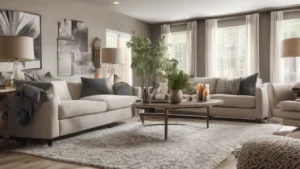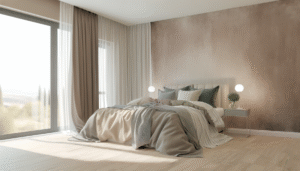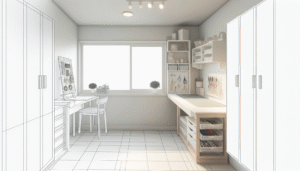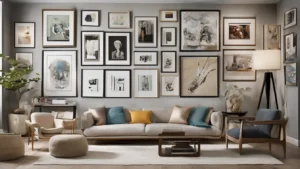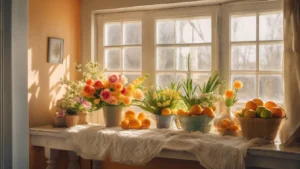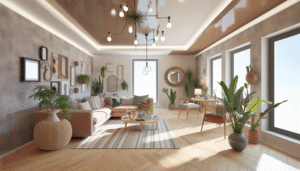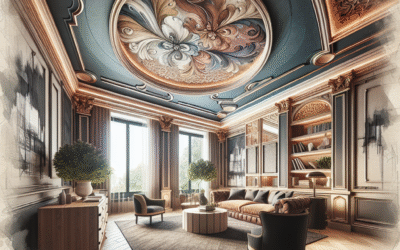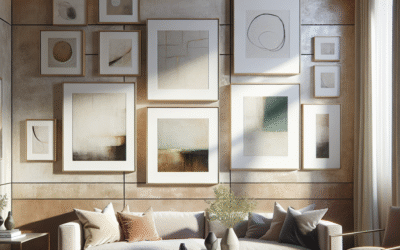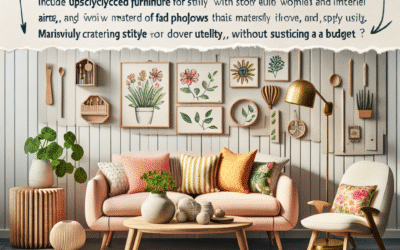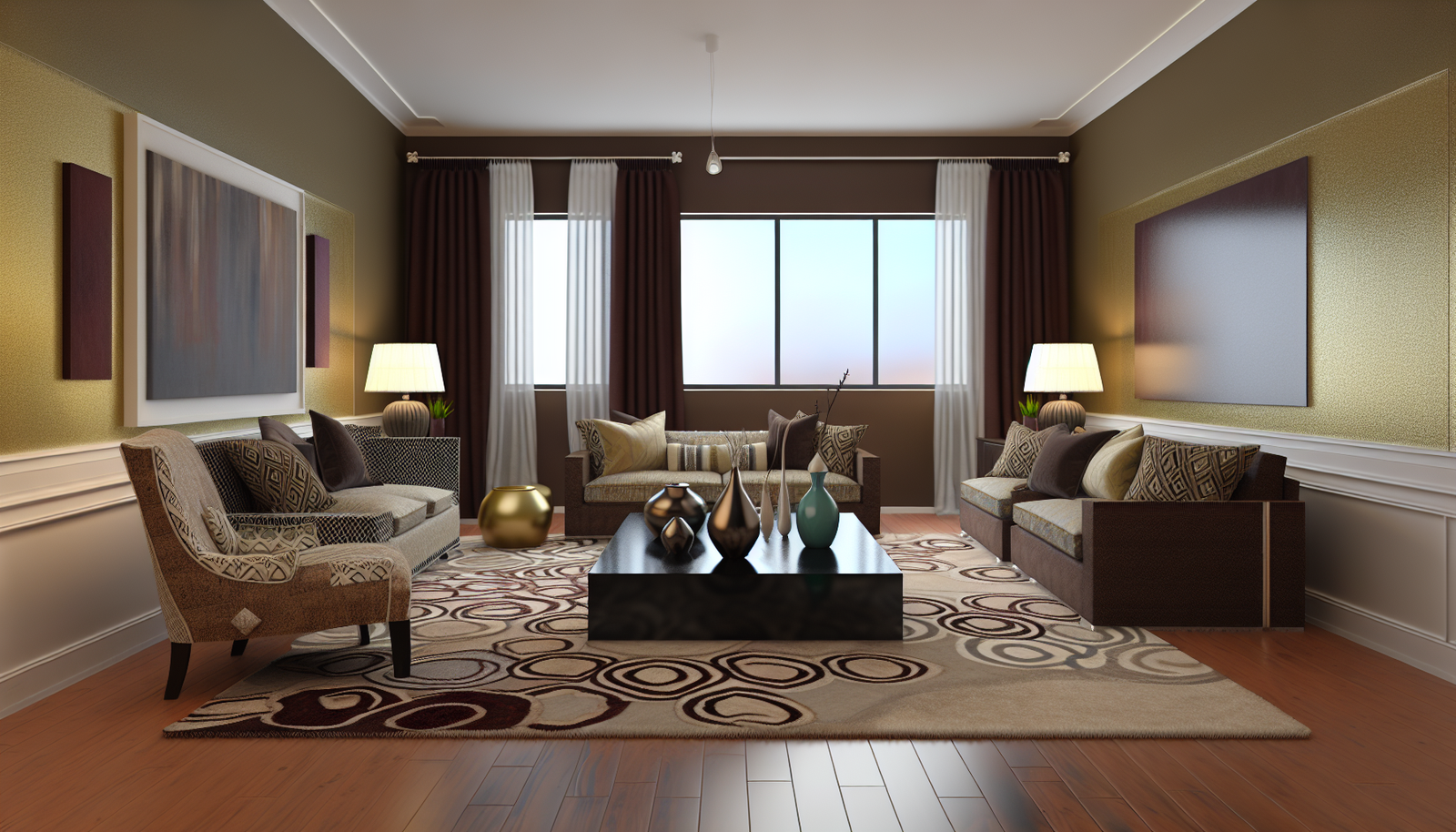
Stepping into a well-designed room, you instinctively feel its warmth, its character, its undeniable *depth*. But how do designers achieve this elusive quality? Often, the secret lies literally underfoot: with the transformative magic of layered rugs. This isn’t just about putting one rug on top of another; it’s about an artful dance of textures, patterns, and colors that utterly transforms a space, adding character and unexpected elegance. If your room feels flat, uninspired, or just a little bit ‘meh,’ mastering the art of designing with depth using layered rugs might just be the interior design epiphany you’ve been waiting for.
From cozy nooks to grand living areas, layered rugs can define zones, introduce new aesthetic narratives, and inject a rich, tactile experience that simpler floor coverings simply can’t match. We’re not talking about haphazardly tossing down a few mats; this is a deliberate strategy that elevates your home’s style from basic to truly bespoke. In this extensive guide, we’ll uncover everything you need to know about selecting the perfect foundation rug, pairing complementary top layers, addressing common pitfalls, and unveiling expert tips to make your layered rug design a resounding success. You’ll learn the secrets to achieving visual interest, textural harmony, and functional brilliance, turning your floors into a captivating canvas that speaks volumes about your personal style.
The Undeniable Appeal of Layered Rugs: Why Embrace This Trend?
Why are interior designers and homeowners alike flocking to the concept of layered rugs? It’s more than just a fleeting trend; it’s a brilliant solution to several common design dilemmas, offering both aesthetic and practical benefits that transform any room. Layering rugs isn’t just about adding more textiles; it’s about strategic design that injects personality and purpose.
1. Instant Infusion of Texture and Warmth
A single rug, no matter how beautiful, can sometimes feel isolated. When you introduce another layer, especially one with a contrasting texture—think a soft, chunky wool over a woven jute—you immediately create visual interest and a tactile invitingness. This strategy of designing with depth adds physical warmth underfoot, making hard floors feel cozier, and softens the acoustics of a room. It’s like wrapping your floor in a comforting embrace, literally enhancing the sensory experience of your space.

2. Defining Zones and Anchoring Furniture
Open-plan living is popular, but it often struggles with a lack of spatial definition. Layered rugs are master problem-solvers in this regard. A larger, foundational rug can define the entire living area, while a smaller, more decorative rug layered on top can subtly delineate a seating arrangement, a reading nook, or even a pathway. This creates smaller, more intimate “rooms within a room,” guiding the eye and providing a clear sense of purpose for each space. It’s a clever way of anchoring furniture groupings, making them feel more cohesive and settled.
3. Economical Style Upgrade: Elevating Existing Pieces
Have a foundational rug you love but feels a bit bland? Or perhaps you’ve fallen for a smaller, high-end rug that’s out of budget in a larger size? Layering offers a brilliant solution. You can use a cost-effective, neutral large rug as a base, then splurge on a smaller, more intricate or patterned rug for the top layer. This instantly upgrades the aesthetic without requiring a complete overhaul of your existing decor. It’s an efficient way to achieve a high-end look on a budget, allowing you to showcase exquisite craftsmanship or bolder patterns without committing to an expansive, expensive floor covering.
4. Injecting Personality and Story
Your home should reflect *you*. Layered rugs provide an incredible canvas for personal expression. You can combine a vintage kilim with a contemporary shag, a tribal pattern over a solid color, or a cherished heirloom with a modern geometric design. Each rug can tell a part of your story, showcasing different periods, travels, or aesthetic preferences. This multi-layered approach to floor decor is a powerful way of designing with depth, adding a unique narrative and a rich character that makes your space truly one-of-a-kind. It moves beyond mere decoration to become a statement piece.
5. Versatility and Adaptability
One of the unsung heroes of layered rug design is its versatility. Seasons change, tastes evolve, and sometimes you just need a refresh. Swapping out the top layer of a rug is much easier and more cost-effective than replacing an entire large area rug. This allows for seasonal updates—a plush sheepskin for winter, a lighter cotton for summer—or a quick style refresh without significant financial commitment. It also makes existing rugs more adaptable; a rug that was perhaps too small for a new space can be given new life as a top layer.
Embracing layered rugs is about more than just aesthetics; it’s a smart, flexible, and deeply personal way to infuse your home with warmth, style, and meaningful design. This strategy of designing with depth is transformative, bringing layers of richness to every room.
The Foundation: Selecting Your Base Rug for Layered Harmony
Every masterpiece, including a beautifully layered rug ensemble, begins with a strong foundation. The base rug is paramount; it sets the tone, provides the scale, and serves as the anchor for your entire layered look. Get this wrong, and your layered rugs might look messy instead of magnificent. The key to successful designing with depth here lies in understanding how the base rug will interact with its partners.
Size Matters: Going Big and Bold
When it comes to the base rug, don’t be shy. Think big. The foundational rug should be large enough to comfortably accommodate the furniture grouping it’s meant to define. For a living room, this usually means all front legs of major seating pieces (sofa, armchairs) should rest on the rug, ideally with enough rug extending beyond for a balanced feel. In a dining room, ensure the rug extends at least 24-30 inches beyond the table on all sides, allowing chairs to be pulled out without snagging. This large canvas is crucial for making the space feel expansive and intentional, creating the necessary visual “room” for the top layer to shine.
- Living Room: All furniture legs on the rug or at least the front two legs of larger pieces.
- Dining Room: Rug extends 24-30 inches beyond the table’s edge.
- Bedroom: Large enough for the bed and nightstands to sit on, extending 18-36 inches on the sides/foot.
Texture and Material: The Workhorse Beneath
The material of your base rug will largely dictate its durability, comfort, and overall vibe. Generally, base rugs should be robust and relatively low-pile, providing a stable surface for the top layer. Natural fibers are often excellent choices for foundational rugs due to their durability and timeless appeal.
| Material Type | Characteristics for Base Layers | Pros | Cons |
|---|---|---|---|
| Jute/Sisal/Seagrass | Natural, textured, durable, earthy tones, flat weave. | Excellent for defining zones, adds organic texture, hides dirt, budget-friendly. | Can be rough underfoot, less soft, may shed initially. |
| Wool (low pile) | Durable, soft yet sturdy, insulating, classic feel. | Luxurious, naturally stain-resistant, great insulator, long-lasting. | Can be more expensive, requires professional cleaning, possibility of shedding. |
| Cotton (flat weave) | Washable, casual, lightweight, often reversible. | Easy to clean (some are machine washable), good for high traffic, versatile. | Less cushion, can feel thin, may curl at edges. |
| Synthetic (e.g., Polypropylene) | Affordable, stain-resistant, wide range of colors/patterns, durable. | Budget-friendly, highly durable, easy to clean, good for families/pets. | Can feel less luxurious, not as eco-friendly, can have chemical odor initially. |
When selecting the base material, consider the room’s traffic, potential for spills, and your desire for softness underfoot. A jute rug, for instance, offers incredible structure and a beautiful textured backdrop, making it ideal for layering with softer, more elaborate pile rugs. A low-pile wool rug provides a more refined, comfortable foundation.
Color and Pattern: The Neutral Canvas
For most layered rug designs, the base rug acts as a neutral canvas. Choose solid colors or subtle patterns that won’t compete with your top layer. Earthy tones like beige, natural, cream, grey, or soft off-whites are popular choices because they provide a calming backdrop. This allows the top rug to introduce bolder patterns, vibrant colors, or intricate designs without making the space feel overwhelmed or visually chaotic. A subtle herringbone or a tone-on-tone basketweave pattern can add interest without overpowering.
Think of your base rug as the dependable older sibling: reliable, supportive, and stylish in its own understated way. It provides the stability and quiet beauty necessary for the top layer to truly shine. Mastering this first step in designing with depth is crucial for creating a cohesive and stunning layered rug look. The right foundation prepares your space for the transformative magic of layered rugs.
The Star of the Show: Choosing Your Top Layer Rug
Once your foundational rug is securely in place, it’s time for the fun part: selecting the top layer rug. This is where your personality explodes, where you introduce that key visual interest, and where the true “magic” of layered rugs comes to life. The top rug is usually smaller, more eye-catching, and often the design focal point. Here, we’re really leaning into the art of designing with depth.
Size and Placement: The Art of Proportion
The top rug should be significantly smaller than the base rug, creating a border or “frame” around it. Typically, it will be at least 1-2 feet smaller on all sides than the base rug. This visual breathing room is essential for showing off both layers and preventing a cramped look. Placement is key. The top rug should generally be centered within your main furniture grouping, or strategically placed under a coffee table, accent chair, or at the foot of a bed. You want it to draw the eye to a specific area, highlighting a particular zone within the larger space.
- Living Room: Centered under a coffee table, or extending just beyond it, ensuring visual balance with the seating arrangement.
- Bedroom: Centered under the bed, often pulling out to frame a bench or seating area at the foot.
- Entryway/Hallway: Often a smaller, vibrant rug over a neutral runner.
Texture and Pile: The Power of Contrast
This is where texture really comes into play, creating that tactile richness so central to designing with depth. The top rug should almost always have a contrasting texture to your base layer. If your base is a flat-weave jute, a high-pile shag, a soft wool, or a plush sheepskin will create a beautiful juxtaposition. This contrast isn’t just visually appealing; it adds a luxurious feel underfoot and distinguishes the layers. Imagine the soft sinking feeling of a sheepskin rug over a firm sisal–that’s the delightful sensory experience you’re aiming for.

Color and Pattern: Making a Statement
With a neutral base, your top rug is your canvas for color and pattern. This is where you can be bold! Consider these approaches:
- Complementary Colors: Select colors that are found elsewhere in your room (throw pillows, artwork, curtains) to create a cohesive palette.
- Contrasting Colors: Introduce an accent color to add visual pop. A vibrant blue over a natural jute, for example.
- Pattern Play: This is a powerful tool for injecting personality.
- Geometric: Think bold lines, chevrons, or Moroccan trellis patterns.
- Abstract: Modern and artistic, perfect for contemporary spaces.
- Vintage/Traditional: Oushak, Persian, or kilim rugs add history and character.
- Animal Print: A classic way to add sophistication and a wild touch.
Don’t be afraid to mix patterns, but remember the “one busy, one calm” rule. If your top rug is wildly patterned, ensure your base is subdued. If both have patterns, ensure one is much more subtle or they share a common color thread to avoid visual chaos. This deliberate contrast is a cornerstone of effective designing with depth with layered rugs.
Style and Origin: Tell Your Story
The top rug often carries the stylistic heart of the layered arrangement. It can hint at a global inspiration (a Moroccan wedding blanket), offer a touch of rustic charm (a cowhide), or scream luxury (a silk-blend with a high sheen). Consider the overall aesthetic you’re striving for in the room. A vintage rug can add soul and history, while a contemporary piece can ground a minimalist space. This choice truly allows you to infuse your unique style into the room and deepen its character.
By thoughtfully choosing your top layer rug, paying attention to its size, contrasting textures, statement-making colors and patterns, and how it aligns with your overall style, you transform a simple floor covering into a dynamic focal point. This is the essence of making your layered rugs truly transformative, moving beyond just covering a floor to actively designing with depth and intention.
Mastering the Art: Practical Tips for Flawless Layered Rug Design
Layering rugs isn’t just about picking two beautiful pieces; it’s about understanding the nuances that make them work together harmoniously. Even with the perfect rugs, poor execution can lead to a clumsy look. Here are expert tips for flawless layered rug design, ensuring a polished, intentional aesthetic that embodies true designing with depth.
1. The Anchor: Non-Slip Pads are Non-Negotiable
This is arguably the most crucial practical tip. Nothing ruins the elevated look of layered rugs faster than a top rug that slips, bunches, or becomes a tripping hazard. Invest in high-quality non-slip pads for *both* rugs. The base rug should have a pad if it’s on a hard floor, and the top rug absolutely needs one, especially if its texture is smooth or low-pile. This ensures safety, keeps your design looking neat, and protects your floors. A simple yet powerful step in ensuring your layered rugs not only look good but function safely.
2. Don’t Fear the Overlap: Embracing Imperfection
While the aesthetic is often about creating a neat frame, sometimes a slight, intentional overlap or offset can add to the organic, lived-in feel. Instead of perfectly centering a rectangular rug over another, try angling a cowhide or sheepskin artfully. This creates a more dynamic composition and prevents the look from becoming too rigid or sterile. It’s about designing with depth in a way that feels natural and effortless.
3. Consider the Room’s Function and Traffic
Think about how the room is used. In a high-traffic area like an entryway, you might opt for a durable, easily cleanable top rug over a sturdy jute base. For a cozy reading nook, a plush, delicate top rug might be perfect. Avoid layering very high-pile rugs in dining areas where chair legs will constantly snag. The functional aspect should always inform your material choices, enhancing the practicality of your layered rugs.
4. The Power of Odd Numbers (Sometimes)
When you’re tempted to add a third, smaller rug (perhaps a sheepskin in front of a fireplace), consider the impact of odd numbers in design. Three rugs can often feel more organic and less “matchy” than two or four. However, this advice comes with a caveat: less is often more. Ensure each layer serves a purpose and truly enhances the space, rather than just adding clutter. This requires a discerning eye for designing with depth without overcomplicating things.
5. Lighting: How It Affects Texture and Color
Always view your rug choices in the actual room where they will reside. Different lighting conditions—natural daylight, warm evening lamps, overhead fixtures—can dramatically alter how colors and textures appear. A beautiful deep blue might look vibrant in a brightly lit showroom but dull in a dimly lit corner. Take samples home, or if purchasing online, ensure decent return policies and check customer photos for real-world examples. The way light plays across various pile heights truly accentuates the depth of your layered rugs.
6. Introduce a Common Thread: Color, Style, or Shape
While contrast is key for texture and sometimes pattern, a subtle commonality can tie the whole look together. This “common thread” might be:
- A Shared Color: Even if one rug is patterned, it might share a background hue or an accent color with the solid base rug.
- Complementary Styles: A modern geometric paired with a minimalist solid, or a bohemian kilim over an earthy jute.
- Related Shapes: A round rug on top of a rectangular one can be stunning, but ensure the curves complement the straight lines.
This subtle cohesion prevents the layered rugs from looking like two unrelated pieces randomly stacked, instead creating a unified, thoughtful design. It’s an advanced technique in designing with depth that brings harmony to diverse elements.
7. Maintenance & Cleaning: Plan Ahead
Layering can make cleaning slightly more involved. Consider how easily each rug can be maintained. Can the top rug be shaken out, spot cleaned, or does it require professional care? Choose materials that align with your lifestyle and comfort level for maintenance. For instance, if you have pets or children, a machine-washable cotton rug as a top layer over a durable synthetic base is a practical choice. Proactive planning helps maintain the beauty of your layered rugs.
By integrating these practical tips, you move beyond just aesthetic choices to truly mastering the art of layered rug design. This thoughtful approach ensures your floors don’t just look good but truly enhance the function and feel of your entire home, making your space profoundly beautiful by designing with depth.
Beyond the Living Room: Layered Rugs in Every Space
While the living room often serves as the most prominent stage for layered rugs, the transformative magic of designing with depth isn’t confined to a single space. From the intimate setting of a bedroom to the high-traffic area of an entryway, layering rugs can add style, warmth, and functionality throughout your entire home. Let’s explore how to implement this dynamic design strategy in various rooms.
1. The Serene Sanctuary: Layered Rugs in the Bedroom
The bedroom is often where softness and comfort are paramount. Layering rugs here can amplify that serene feeling while also adding luxurious depth and defining zones. Imagine stepping out of bed onto a plush, smaller rug, a cozy oasis for your feet.
- Base: A large, soft, low-pile wool or an expansive natural fiber rug that extends well beyond the bed frame, covering the area under the nightstands. This visually anchors the entire bed ensemble.
- Top: A smaller, exceptionally soft rug. Think a faux fur, sheepskin, or a high-pile shag at the foot of the bed or off-centered to create a pathway or a reading nook beside the bed. This is where you can introduce a rich color or subtle pattern to complement your bedding.
- Consideration: Ensure the top rug doesn’t impede movement or snag on bedskirts. Safety with non-slip pads is crucial, especially in spaces where you might be walking in the dark.
2. The Welcoming Threshold: Layered Rugs in the Entryway
The entryway is your home’s first impression, and layered rugs can make it instantly more inviting and stylish. This space benefits from durability and clever design.
- Base: A durable runner or a rectangular rug in a hard-wearing material like jute, sisal, or a synthetic blend that can withstand heavy foot traffic and potential moisture from outside.
- Top: A smaller, more decorative rug with an interesting pattern or texture. This could be a vintage kilim, a bold geometric design, or even a small cowhide. It introduces personality without sacrificing practicality.
- Consideration: Both rugs *must* have non-slip pads for safety. Choose materials that are easy to clean or disguise dirt well to maintain a fresh appearance.
3. The Culinary Hub: Layered Rugs in the Kitchen (Carefully!)
Layering rugs in the kitchen requires careful consideration due to spills and heavy use, but it can be done to add warmth and softness. This is a nuanced application of designing with depth.
- Base: If using a base, choose a durable, washable kitchen runner (e.g., synthetic, cotton flat-weave) that spans the length of your work area or aisle.
- Top: A smaller, highly durable, and easily washable cotton or synthetic rug placed strategically in front of the sink or stove. This adds a soft spot for standing and can introduce color.
- Consideration: Avoid high-pile rugs; they trap food and can be a tripping hazard. Prioritize stain-resistance and ease of cleaning above all else. This application is more about functional layering than purely aesthetic.

4. Creative Corners: Layering in Offices, Nurseries, and Beyond
Don’t limit your imagination! Layered rugs can enhance smaller, specialized areas:
- Home Office: A larger rug to define the workspace under the desk and chair, topped with a smaller, softer rug for aesthetic comfort.
- Nursery: A plush, machine-washable rug over a larger, durable base can create a soft, safe play area.
- Reading Nook: A small, natural fiber rug, topped with a luxurious sheepskin or faux fur, transforms a simple corner into an irresistible escape.
- Bathroom: (with caution) A bath mat over a waterproof, anti-slip base runner in a larger bathroom can add a spa-like feel, but ensure everything is highly absorbent and quick-drying.
The key to successful layering in any room is to understand the room’s primary function and traffic patterns. By thoughtfully adapting the principles of size, texture, and pattern contrast, layered rugs can become a powerful tool for designing with depth and charm throughout your entire home, enriching every space with unique character and comfort.
Common Pitfalls and How to Avoid Them in Layered Rug Design
While the concept of layered rugs is wonderfully versatile, it’s easy to stumble into common traps that can make your space look cluttered rather than curated. Avoiding these pitfalls is crucial for successfully designing with depth and achieving that transformative magic. Let’s uncover the mistakes and how to sidestep them for a truly polished result.
1. Base Rug is Too Small: The “Floating Island” Effect
This is perhaps the most common mistake. A base rug that’s too small for your furniture grouping makes everything look disconnected and awkward. Instead of anchoring the space, it creates a “floating island” where furniture legs awkwardly spill off. This diminishes the feeling of depth and cohesion.
- Solution: Always ensure your base rug is generously sized. For a living room, aim for at least the front two feet of all major furniture pieces (sofa, chairs) to rest comfortably on the rug. In a dining room, ensure chairs can be pulled out without sliding off. Check out this guide for rug sizing tips for various rooms. This expansive base is vital for a feeling of intentionality and proper scale when designing with depth.
2. Lack of Texture Contrast: Flat and Uninspired
If both your base and top rugs have similar pile heights and textures, you lose the very essence of layering. The result is often visually flat and lacks the rich tactile experience that layered rugs promise. It looks more like two rugs accidentally overlapping than a deliberate design choice.
- Solution: Embrace contrast! Pair a low-pile, flat-weave rug (like jute or sisal) with a high-pile, plush rug (like shag, faux fur, or soft wool). Or, if both are low-pile, ensure a stark difference in weave or pattern provides the contrast. The interplay of different textures is a cornerstone of impactful designing with depth.
3. Competing Patterns: Visual Overload
While mixing patterns can be exciting, doing so without a clear strategy leads to visual chaos. If both your primary and secondary rugs feature busy, bold patterns with contrasting color palettes, the eye doesn’t know where to rest, and the room feels overwhelming.
- Solution: Usually, the base rug should be a solid color or a very subtle, tone-on-tone pattern. This provides a calm backdrop for a more vibrant, patterned top rug. If you *must* use two patterned rugs, ensure one pattern is significantly larger or bolder than the other, or that they share a common color family to create harmony. Think of patterns as conversations; you don’t want everyone speaking at once.
4. Ignoring Scale and Proportion: Awkward Juxtaposition
Beyond the base rug being too small, a top rug that’s too large or too small in relation to the furniture can throw off the entire balance. A top rug that nearly covers the base rug negates the layering effect, while one that’s tiny might look like an afterthought.
- Solution: The top rug should leave a clear border of the base rug visible, typically 1 to 2 feet on all sides. It should be proportional to the furniture it’s intended to highlight, often centered around a coffee table or a specific seating arrangement. This ensures each layer contributes meaningfully to the overall design, fostering a sense of harmony when designing with depth.
5. Forgetting Safety: The Slippery Slope
Layered rugs, especially without proper anchoring, can be a serious tripping hazard. A beautiful design isn’t worth a fall.
- Solution: Always, and we mean *always*, use high-quality non-slip rug pads for *both* the base rug (if on hard flooring) and the top rug. These not only prevent slipping but also add a layer of cushioning and extend the life of your rugs. Prioritizing safety is a non-negotiable step in smart layered rug design.
6. Lack of Cohesion: Mismatched Aesthetics
Jumping on the layering trend without considering your existing room aesthetic can lead to a disjointed look. If your room is traditionally styled, two ultra-modern, abstract rugs might feel out of place, even if beautifully layered.
- Solution: Ensure your layered rugs, individually and as a pair, complement your room’s overall style, color palette, and existing decor. They don’t have to match perfectly, but they should belong together, perhaps sharing a color, a style family (e.g., both bohemian, both modern), or a general vibe. This thoughtful integration is what truly defines successful designing with depth.

By being mindful of these common pitfalls, you can confidently approach your layered rug design, creating spaces that are not only beautiful and deep but also cohesive, safe, and truly reflective of impeccable taste. The magic of layered rugs lies in the details.
Case Studies in Layered Luxury: Realizing the Potential of Designing with Depth
The theory of layered rugs is one thing, but seeing it in action truly illuminates its transformative power. These hypothetical case studies showcase how designing with depth using layered rugs can solve specific design challenges and elevate a space from ordinary to extraordinary. Each example highlights different strategies for achieving unique aesthetics and functionalities.
Case Study 1: The Urban Loft – Industrial Meets Bohemian
The Challenge:
A sprawling urban loft with polished concrete floors and exposed brick walls felt stark and cavernous. The client wanted to create distinct, warm zones within the open-plan living area without building physical dividers, and inject bohemian warmth while respecting the industrial shell.
The Layered Rug Solution:
- Base Rug: An oversized (10×14 ft) natural jute rug with a subtle chevron weave was chosen. Its earthy tone and robust texture provided a grounding presence against the cool concrete, immediately defining the living zone and adding an organic, almost raw, texture that complemented the brick. (Cost-effective, durable).
- Top Rug: A smaller (6×9 ft) vintage Oushak rug with faded warm reds, blues, and creams. Placed centrally under the main coffee table, this intricate pattern and shorter, soft wool pile introduced the desired bohemian aesthetic. Its softer texture contrasted beautifully with the jute and concrete, creating a luxurious focal point for the seating area.
- Result: The layered rugs successfully softened the stark industrial elements, creating a visually distinct, warm, and inviting living zone. The juxtaposition of natural, raw texture with a rich, historical pattern created an artful balance, embodying casual luxury through designing with depth. The large base rug anchored the seating arrangement, while the top rug added a burst of personality and comfort.
Case Study 2: The Small Apartment – Maximizing Perceived Space and Coziness
The Challenge:
A small studio apartment needed to feel larger and multifunctioning, with a clear distinction between the living and sleeping areas, all while maintaining a cozy, personalized feel. The existing floor was standard oak laminate, providing no inherent character.
The Layered Rug Solution:
- Base Rug: A large (8×10 ft) light grey, low-pile synthetic rug was used to cover the majority of the ‘living’ half of the studio. This neutral, unobtrusive base expanded the perceived size of the area, unifying the space without overwhelming it. (Stain-resistant, affordable).
- Top Rug: A fluffy, ivory faux sheepskin rug (5×7 ft) was strategically placed over the base, extending partially under a small sofa and pulled forward to define a cozy reading/relaxation zone with a floor pillow.
- Result: The layered rugs created an illusion of greater spaciousness with the lighter base, while the plush top rug instantly carved out an intimate, inviting zone. The textural variation added interest, and the soft top layer made the small space feel incredibly cozy and luxurious, showcasing how layered rugs can maximize both space and comfort through clever use of designing with depth.
“Layering multiple rugs in a space creates an unparalleled sense of depth and richness. It’s like adding dimension to an otherwise flat painting, transforming a simple room into a complex and inviting narrative.” – Emily Henderson, Renowned Interior Designer
Case Study 3: The Formal Dining Room – Adding Elegance and Personality
The Challenge:
A formal dining room, while elegant, felt a bit cold and lacked personality. The client wanted to inject color and warmth, but also ensure the rug choice wouldn’t make the space overly casual or interfere with chair movement.
The Layered Rug Solution:
- Base Rug: A large (9×12 ft) short-pile, sophisticated dark navy wool rug was chosen. This deep color added instant richness and maturity, anchoring the dining table and chairs completely and providing excellent sound absorption. Its low pile ensured chairs would glide easily.
- Top Rug: A smaller (5×7 ft) antique Persian rug with a delicate pattern in muted jewel tones (burgundy, emerald, gold) and subtle fringing. This was placed centrally under the dining table, allowing the sophisticated navy border of the base rug to frame it beautifully.
- Result: The formal dining room was instantly transformed. The dark navy base provided a tailored, opulent foundation, while the antique Persian rug introduced historical charm, intricate pattern, and a pop of muted color. The layering added significant visual interest and warmth, preventing the large room from feeling sterile, yet maintaining its sophisticated ambiance. This demonstrated precise designing with depth in a formal setting.

These case studies illustrate that layered rugs are far more than just a decorative choice. They are a powerful design tool capable of defining spaces, injecting personality, adding warmth, and solving complex aesthetic and functional problems. By carefully considering the interplay of size, texture, color, and pattern, anyone can harness the transformative magic of designing with depth to create truly captivating interiors.
Curating Your Collection: Tool Recommendations and Resourceful Finds
Embarking on your layered rug design journey means you’ll eventually need to find the perfect pieces. The good news is that the market offers an incredible range of rugs, catering to every style and budget. Being resourceful and knowing where to look can make all the difference in curating your unique collection for designing with depth. Here are some recommendations and tips for finding those transformative pieces.
1. Reputable Online Retailers: Convenience at Your Fingertips
Online rug stores offer unparalleled selection and competitive pricing, often with good return policies, which is essential when you can’t physically interact with the rug beforehand.
- Rug Source: Known for a vast selection of machine-made and hand-knotted rugs, often with sales.
- Wayfair/Overstock: Excellent for budget-friendly foundational rugs (jute, synthetics) and a wide range of styles for top layers. Read reviews for quality checks.
- Boutique Rugs: Often features unique, curated collections and often has promotions, great for more distinctive top layers.
- Revival Rugs: Specializes in vintage and antique hand-knotted rugs, perfect for adding character as a top layer. A bit higher price point, but unmatched quality and uniqueness.
- Rugs USA: Another major player with frequent sales and a wide variety, from high-pile shags to flat weaves.
Pro Tip: Always check customer photos and reviews. They often give a much more realistic depiction of color and texture than professional product shots. Order swatches if possible, especially for color matching.
2. Sustainable and Natural Fiber Powerhouses: The Eco-Conscious Choice
For durable, eco-friendly base layers, natural fibers are a fantastic choice. Many brands focus specifically on these materials, allowing you to source responsibly while achieving fantastic texture.
- The Citizenry: Offers beautifully handcrafted rugs from around the world, focusing on ethical sourcing and natural fibers. Excellent for unique top layers with a global aesthetic.
- Pottery Barn/West Elm/Crate & Barrel: Offer a good selection of quality jute, sisal, and wool rugs that make excellent base layers, often with coordinating styles for a cohesive look.
- Boutique Weavers: Many smaller independent brands on platforms like Etsy specialize in handwoven jute or cotton flat-weaves, providing a unique touch for your layered rugs.
3. Vintage & Antique Finds: Unearthing Personality
Vintage rugs are exceptional for adding soul, history, and unmatched character as top layers. Their faded patinas and unique patterns are perfect for truly designing with depth.
- Local Antique Stores & Flea Markets: A treasure trove for unique finds. Be prepared to hunt, and inspect for condition (stains, wear, odors). Bargaining is often possible!
- Etsy & eBay: Search for “vintage Persian rug,” “Oushak,” “kilim,” “Moroccan rug.” Filter by size, price, and origin. Many sellers specialize in sourcing and cleaning these.
- Chairish / 1stDibs: Higher-end platforms for expertly curated vintage and antique pieces, if your budget allows for investment pieces.
Buyer Beware for Vintage: Always ask for detailed photos of any imperfections, understand the material (wool, cotton, silk), and be aware that colors can vary significantly from screen to real life. Factor in professional cleaning if unsure of provenance.
4. Rug Pads: The Unsung Hero
Don’t skimp on rug pads! They are essential for safety, longevity, and comfort in your layered rug design. There are different types for different needs:
- Grip Pads: Thin, mesh-like, best for preventing slipping on hard surfaces.
- Cushion Pads: Thicker felt or rubber pads, offering cushioning, sound dampening, and slip resistance. Ideal for comfort under your top layer.
- Combination Pads: Offer both grip and cushion.
Recommended Brands: Ruggable (also offers washable rugs), Mohawk Home, Gorilla Grip—many online retailers now offer their own branded, quality rug pads. Ensure the pad is slightly smaller than the rug itself to avoid it showing.
5. Visualize Before You Buy: Tools to Help
- Augmented Reality Apps: Many online rug retailers (e.g., Rugs USA, Wayfair) have AR features in their apps, allowing you to “see” a rug in your room via your phone camera. This is fantastic for visualizing size and color.
- Mood Boards: Collect images of your existing furniture, wall colors, and decor, then digitally (or physically) add images of potential base and top rugs to see how they interact.
Curating your collection for layered rugs is an exciting process that blends practical considerations with aesthetic discovery. By leveraging these recommended tools and resourceful finds, you can confidently source the perfect pieces to bring your vision of designing with depth to life, creating a space that feels uniquely yours and utterly captivating.
FAQ: Your Layered Rug Design Questions Answered
Q: Can I layer rugs on carpet?
A: Yes, absolutely! Layering rugs on carpet is a fantastic way to introduce texture, patterns, and to define zones within a carpeted room. Since a carpeted floor offers some padding, your primary concern will be preventing the layered rug from bunching or shifting. Use a non-slip rug pad specifically designed for carpet-on-carpet applications. These usually have a slightly tacky texture or different grip patterns to prevent movement. This technique is particularly useful if your wall-to-wall carpet is neutral or bland, allowing a vibrant layered rug to become a focal point, injecting personality and color.
Q: What’s the ideal size difference between the base and top rug?
A: Generally, you want the top rug to be significantly smaller than the base rug, creating a visible “frame” around it. A good rule of thumb is to have at least 1 to 2 feet of the base rug showing on all sides of the top rug. For instance, if your base rug is 8×10 feet, a top rug around 5×7 or 6×9 feet would work well. The exact dimensions will depend on the overall size of your room and furniture grouping, but aim for a clear disparity in size to highlight the layering effect and ensure proper scale when designing with depth.
Q: Do layered rugs work in small spaces?
A: Yes, layered rugs can be highly effective in small spaces, used strategically. The key is to use a large, light-colored base rug to expand the perceived size of the room, then layer a smaller, textured, or patterned rug to define a cozy zone (like a seating area or reading nook). Avoiding too many competing patterns and ensuring the rugs are well-proportioned to the furniture will prevent the space from feeling cluttered. When done right, designing with depth using layered rugs can make small spaces feel more intimate, interesting, and luxurious, rather than cramped.
Q: How do you prevent layered rugs from slipping or bunching?
A: The most critical step is to use high-quality non-slip rug pads for both rugs. If the base rug is on a hard floor, ensure it has a proper grip pad. The top rug absolutely needs a non-slip pad to keep it in place on top of the base rug. For added security, some designers use rug tape or sticky rug grippers strategically placed under the edges of the top rug. Additionally, ensure both rugs are flat and heavy enough to resist movement. Proper pad choice is foundational for safe and beautiful layered rugs.
Q: Can I mix different rug styles (e.g., modern and traditional) when layering?
A: Absolutely! Mixing styles is one of the most exciting aspects of designing with depth through layered rugs. A modern geometric rug over a traditional Persian rug, or a rustic jute base with a contemporary abstract top, can create incredibly dynamic and personalized spaces. The trick is to find a common thread – perhaps a shared color in their palettes, similar undertones (cool or warm), or a complementary texture that prevents them from clashing. This thoughtful juxtaposition adds rich character and a sophisticated, collected feel to your home.
Q: How do I clean layered rugs?
A: Cleaning layered rugs depends heavily on their materials. For daily maintenance, regular vacuuming (using appropriate settings for pile height) of both rugs is usually sufficient. For spills, immediate spot cleaning as per the rug’s care instructions is crucial. For deeper cleaning, the top rug can often be taken outside for shaking or smaller ones can be machine-washed (if suitable). Larger, high-quality wool or vintage rugs may require professional cleaning to preserve their integrity. Consider the maintenance needs when selecting your rugs, especially for high-traffic or spill-prone areas, to ensure the longevity of your beautiful layered rugs.
Q: What kind of rug works best as a base?
A: The best base rugs are typically large, durable, relatively low-pile, and often in a neutral color or subtle pattern. Materials like jute, sisal, seagrass, low-pile wool, or durable synthetics (e.g., polypropylene) are excellent choices. They provide a stable, unobtrusive foundation that defines the space without competing for attention, allowing your more decorative top rug to shine. A good base rug is the unsung hero, providing the essential canvas for your layered rug design, embodying the quiet power of designing with depth.
The Final Layer: Embracing the Transformative Power of Layered Rugs
We’ve journeyed through the intricate world of layered rugs, uncovering their profound ability to transform a flat room into a vibrant, multi-dimensional space brimming with personality and warmth. This isn’t just a fleeting trend; it’s a timeless design strategy for designing with depth that speaks to our innate desire for comfort, character, and visual intrigue in our homes. From the foundational decision of a robust base rug to the artistic flourish of a carefully chosen top layer, every step in this process contributes to a richer, more inviting interior.
By consciously choosing to layer, you’re not just placing rugs; you’re orchestrating a symphony of textures, patterns, and colors that tell a unique story about your space and your style. You’re defining zones, introducing luxurious comfort, and injecting an unparalleled sense of charm that makes a house feel like a cherished home. Remember the power of contrast in texture, the importance of scale, and the non-negotiable role of safety with non-slip pads. These principles are your guiding stars in creating a functional masterpiece beneath your feet.
Now, it’s your turn to embrace this transformative magic! Look around your home. Which room feels like it needs an extra layer of soul? Perhaps your living room could benefit from a cozy sheepskin atop a natural jute, or your bedroom could use a splash of vintage color to define its sleeping sanctuary. Don’t be afraid to experiment, to mix high-end with budget-friendly, and to let your personality shine through with thoughtful combinations. The beauty of designing with depth through layered rugs lies in its flexibility and its capacity for boundless creativity.
So, take the plunge. Uncover the potential lying dormant in your floors and unleash the transformative magic. Your home, and your feet, will thank you. For more inspiration and to discover rugs that perfectly fit your vision, explore Revival Rugs’ curated collection of vintage pieces or broaden your search with reliable retailers like Boutique Rugs. Happy layering!
Content Disclaimer
This article provides general information and guidance on interior design principles and product selection related to layered rugs. It is intended for educational and informational purposes only and does not constitute professional advice. While we strive for accuracy, individual results may vary based on personal circumstances, product quality, and specific design choices. We recommend consulting with professional interior designers for personalized advice if needed. Product recommendations are based on general market research and editorial opinion and are not endorsements. Always read product labels and care instructions carefully. Some links provided may be to external commercial sites and are included for informational purposes only, not as affiliate promotions in this instance.
Categories
- Accent Walls & Ceilings (61)
- Art Curation & Gallery (62)
- Bedding Style Trends (68)
- Bedroom Makeover (81)
- Bohemian & Eclectic Styles (58)
- DIY & Budget-Friendly Decor (64)
- Eco-Friendly Design (62)
- Furniture Care (71)
- Home Decor & Design Ideas (162)
- Home Wellness Spaces (59)
- Integrated Outdoor Living (67)
- Japandi Style (61)
- Kids and Nursery Decor (59)
- Living Room Decor (79)
- Mix & Match Techniques (73)
- Modern & Contemporary Design (66)
- Rug Sizing & Placement (73)
- Scandinavian Design Inspiration (22)
- Seasonal Home Decor (79)
- Small Space Solutions (73)
- Wall Art & Painting Tips (77)
Recent Comments
Archives
Product Gallery
-
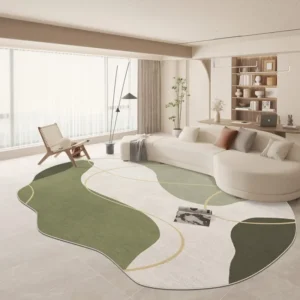 Large Area Green Rugs for Bedroom Nordic Living Room Decoration Shaped Carpet Irregular Plush Lounge Rug Home Thick Washable Mat
Rated 5.00 out of 5$55.01 – $346.86Price range: $55.01 through $346.86
Large Area Green Rugs for Bedroom Nordic Living Room Decoration Shaped Carpet Irregular Plush Lounge Rug Home Thick Washable Mat
Rated 5.00 out of 5$55.01 – $346.86Price range: $55.01 through $346.86 -
 Nordic Style Rugs for Bedroom Morandi Living Room Decoration Carpet Large Area Geometry Lounge Rug Home Cloakroom Non-slip Mat
Rated 5.00 out of 5$39.51 – $598.43Price range: $39.51 through $598.43
Nordic Style Rugs for Bedroom Morandi Living Room Decoration Carpet Large Area Geometry Lounge Rug Home Cloakroom Non-slip Mat
Rated 5.00 out of 5$39.51 – $598.43Price range: $39.51 through $598.43 -
 Irregular Shapes Living Room Decoration Carpet Modern Style Rugs for Bedroom Home Thicken Plush Rug Fluffy Soft Lounge Floor Mat
Rated 4.83 out of 5$55.91 – $347.82Price range: $55.91 through $347.82
Irregular Shapes Living Room Decoration Carpet Modern Style Rugs for Bedroom Home Thicken Plush Rug Fluffy Soft Lounge Floor Mat
Rated 4.83 out of 5$55.91 – $347.82Price range: $55.91 through $347.82

